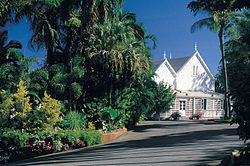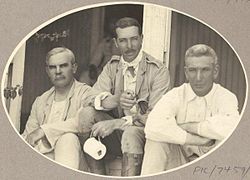History
Government House is the oldest European building in the Northern Territory. Government House has been the home of successive Government Residents and Administrators since 1871. The house is an example of a mid-Victorian Gothic villa, here adapted for the local climate by the addition of numerous shaded verandahs and porches. It has endured cyclones, earthquakes, enemy bombing raids, infestations of white ants and rowdy public demonstrations to remain one of the most spectacular and attractive buildings in Darwin.
Of its construction early resident Harriet Douglas Daly said: [1]
Building this house was a matter of great difficulty...In fact the word seems to be the one most frequently associated with every...enterprise connected with the Northern Territory...Robinson Crusoe had nothing like the difficulties in obtaining building material that we had...we literally had to begin at the beginning of everything...from the very laying of the foundationstone...nothing but difficulties and makeshifts attended the work
— Harriet Douglas Daly, Digging, Squatting, and Pioneering Life in the Northern Territory of South Australia, 1887, p. 109
On 17 December 1918, Government House became the focal point of political turmoil and union unrest against John Gilruth's administration. About 1000 demonstrators marched to Government House where they burnt an effigy of Gilruth and demanded his resignation. The incident became well known as the Darwin Rebellion. [2]
Government House was entered on the now-defunct Register of the National Estate on 14 May 1991 and was added to the Northern Territory Heritage Register on 19 March 1996. [3] [4]
This page is based on this
Wikipedia article Text is available under the
CC BY-SA 4.0 license; additional terms may apply.
Images, videos and audio are available under their respective licenses.



